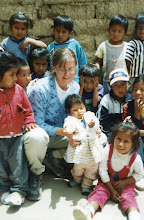
Here is the first test of the Blog. Is the above photo Machu Picchu? Most people would not recognize the shot of the mountain as Machu Picchu, but it is! The ruins of Machu Picchu are set in the saddle between the two mountains of Wayna Picchu and Machu Pichu. All the famous photos are taken from the slopes of Machu Picchu of the ruins with Wayna Picchu as the backdrop.

I made it! I can cross one thing off my ¨bucket list¨ This photo was taken earlier in the morning before the tour, after my first peek at the ruins.

One of my first detailed photos of the northeast side in the early morning sunshine.

Another early morning shot of the northeast side. There are some agricultural terraces before the drop off down the steep mountain slope.

This shows the amazing Inca masonry. Cement does not hold the stone work together, they are cut and shaped to fit perfectly together. All the stone was quarried from the top of the mountain, which is good news for the workers who came for a month or two a year, to pay their taxes through labor. There is still a major field with rocks available for expansion. (which they may need to use, as so many people have robbed rocks from this important site.)

Machu Picchu seems to be created for the ruling and comercial class, though actual facts and historical data are absent. The ornamentation and high quality of stonework point to Machu Picchu being a royal retreat or important cermonial center. People lived there for about 100 years, which looked to have been abandoned when the Spanish invaded the region. The above photo is taken of the industrial center, with the residential sector to the left fading into the distance.

My new friends from Argentina who were in my tour group. Very international group, people were from 7 different countries. My new friends asked lots of great questions, such as where did all the workers live? They atually did not live above in the ruins but further below, closer to the river, though ruins of their houses were not on the tour. Issues revolving around migrant labor are not a modern issue but ancient in existence.

These huts were located at the edge of the agricultural terraces. They have been restored as far as the thatched roofs are concerned to give a feel of what it may have been like, very few roofs in the ruins have actually been restored. (the view is looking toward southeast)

As I ended my day, I hung out on the southwestern side, many people had left and it was much quieter. Above is a detail (of the below photo) of more agricultural terraces at the edge of the community. I had never noticed before in the classical postcard shots, until a Peruvian pointed out that the mountain of Wayna Picchu looks like the profile of a head in repose. I couldn't help but notice this, it is most obvious in the photo of me and the Agentinians.





Machu Picchu looks as breathtaking as it did when I was in Peru for one of our college travel trips! You look great Catherine. Hope all is well. We missed seeing you @ our 30th reunion, maybe we'll get to see you at our next one in 5 years. Stay safe & be well!
ReplyDeleteCandida Weaver Huber